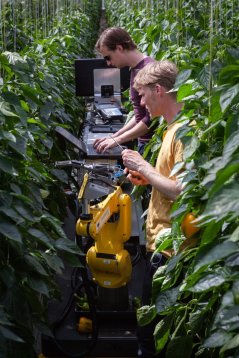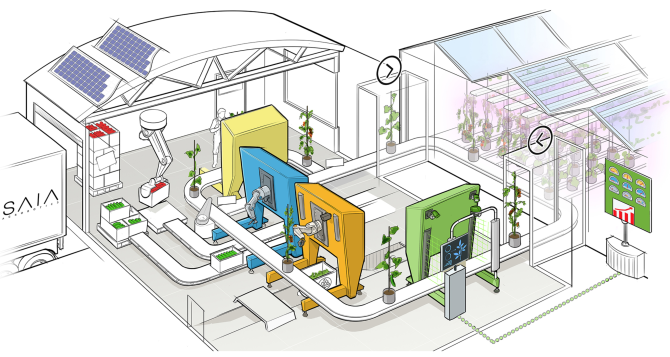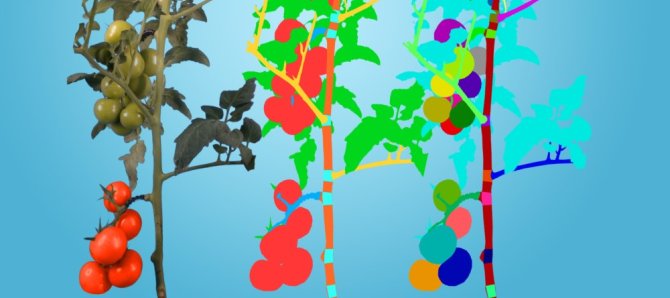
News
SAIA works on Robotics and Artificial Intelligence in Greenhouse Horticulture
SAIA Agrobotics, a tech spin-off of Wageningen University & Research (WUR) situated on the Droevendaalsesteeg, specialises in the development of robotics technology to support human activities in greenhouse horticulture. ‘Automation is the path to growth in this sector, reducing its dependence on labour. We aim to facilitate this process through robotics and artificial intelligence (AI), as the demand for vegetables is increasing globally’, says co-founder and SAIA CEO Ruud Barth. He founded this startup with co-founder and CTO (Chief Technology Officer) Bart van Tuil two years ago.
What is SAIA Agrobotics’ core business, and who are its customers?

The acronym SAIA stand for Sowing Artificial Intelligence in Agriculture. Our startup has a long history. Wageningen Greenhouse horticulture has been working on technology to further automate the sector for a long time. Bart started developing a cucumber harvesting robot twenty years ago and has a lot of expertise in mechanical designs for food systems. I joined this research eight years ago and worked mainly on image recognition, artificial intelligence (AI) and robot control. Robotics had matured in the meantime, and this inspired us to bring our knowledge to the market by starting a spin-off. We felt that both the technology and the market were ready. We followed an incubation programme with StartLife and wrote a business plan around the question of what product would best suit the market. Because the main global issue is finding sufficient skilled labour for work in greenhouses, we wanted to address this issue by developing a robot that picks leaves off the cucumber crop to begin with.
"Bringing a plant to a robot is one step closer to an autonomous greenhouse"
Alternative thinking
The original plan was a mobile robot that you more or less blindly deploy into the greenhouse. But, to really make a difference, we changed our approach: instead of a robot that comes to the pant, we bring the plant to the robot. This method is already used in the ornamentals sector, but not for large vegetable crops such as tomato, bell peppers or cucumber. In order to move the plant, its growth must be curbed, which has the added advantage of keeping the space around the plant clear. This creates an orderly process, which allows you to gather plenty of data and save on labour expenses. This idea brings us one step closer to an autonomous greenhouse and is a better business case than mobile robots.
The concept of a moveable plant was, however, impossible to achieve in an existing greenhouse, which led to a new challenge: designing a complete cultivation system for multiple crops. A system that is both robust and can be applied on a large scale. So, we took a step back in our thinking process. From a mobile robot all the way back to developing a new cultivation system in which a robot and AI are able to operate optimally.

How many, and what kind of, employees work with you?
Bart and I started out with just the two of us. Since then, we have employed three colleagues. One so-called crop engineer with expertise on plants who focuses on optimising the cultivation system, an AI engineer who is specialised in image recognition and robotics and a mechatronics engineer. If we are able to acquire sufficient funding for our product, we hope to grow significantly over the next few years and fully automate the first greenhouse.
On the subject of funding… You are funded by, among others, Gelderland province?
Indeed. We receive subsidies from Oost NL through ION+, an innovation platform for small and medium enterprises in Gelderland. Oost NL manages the ION+ funds. Moreover, we receive funding from the Thematic Technology Transfer (TTT) funds of Innovation Industries and SHIFT Invest. These TTT funds invest in promising startups that originate from university spin-offs. These funds have been made available by a partnership with the four Dutch technical universities, TNO and Rijksdienst Ondernemend Nederland (Government Service for Dutch Entrepreneurs). At this stage, we are dependent on venture capital, as the risk of failure is still high. This is something we must bear in mind. A rule of thumb states that only one in ten startups develops into a viable business. There may be financial or technical failures even if you do everything right. We work very hard to make it a success, but you must take the low success rate into account.
Why did you settle on the campus, and what are the advantages?
We come from the campus and have frequent interaction with the right experts. Thus, we stay connected to the people in our old research group and make new contacts. And, of course, we benefit from WUR’s reputation. There are many visitors on campus who also visit us. Moreover, we frequently visit StartLife and collaborate with students.
"Everyone on the campus knows and supports each other. That is not the case if you are in a cabin in the woods"
Are there advantages to being housed so close to other budding businesses?
Certainly. In the beginning, you learn from each other, and you build a good network of interested parties. Everyone knows each other, which is useful. That is not the case if you set up shop in a cabin in the woods. You can and must support each other in the starting phase.
Do you use facilities/equipment on campus?
Yes, we use the Unifarm greenhouses. The greenhouses at Greenhouse Horticulture in Bleiswijk are a little too far away at this stage.

Is there anything you miss on campus?
Well, the Unifarm greenhouses are some twenty years old. The greenhouses are low, and it is impossible to control the climate. We would like to test our discoveries in a modern, high greenhouse. It would be great if there was a startup facility for greenhouse horticulture on the campus, with good, state-of-the-art compartments. Or, we could erect a greenhouse of our own on the campus if we are able to acquire funding, of course.
How do you see the future of the campus?
That depends entirely on what type of business we will develop into. If we remain an R&D business, we will remain on the campus, close to the expertise. If we become a production company, we will most likely move to the greenhouse region in the west. Personally, I feel that we will always maintain some kind of presence on the campus. It is beautiful and inspiring here.
- Unfortunately, your cookie settings do not allow videos to be displayed. - check your settings